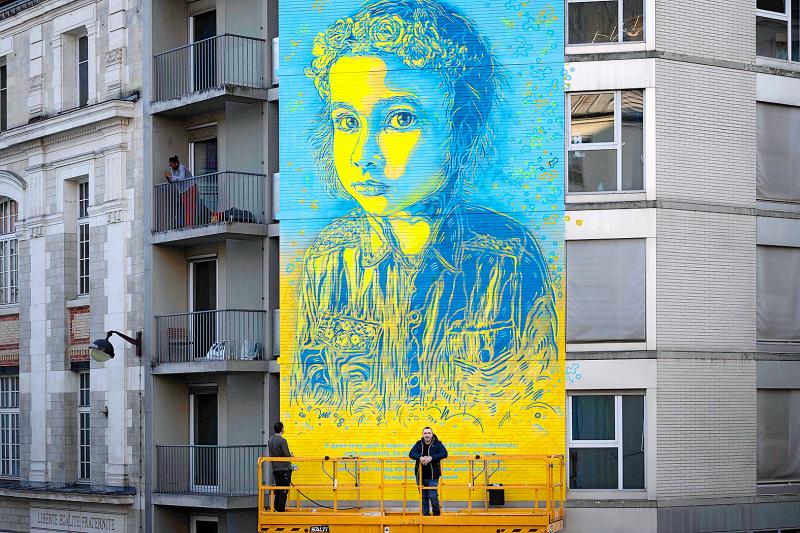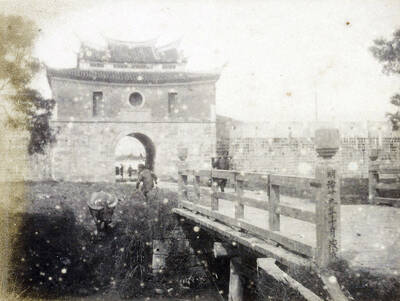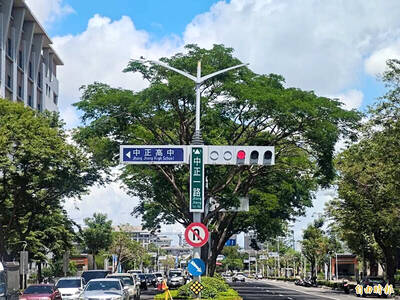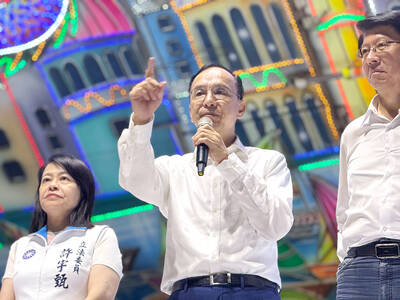The huge blue-and-yellow mural covering the side of a Paris apartment block is a reminder, says Paris-based artist C215, of the human cost of the war in Ukraine. But it is also testament to the talents of a man whose graffiti skills helped him overcome a traumatic youth to become one of France’s leading street artists — a one-time Banksy collaborator who has tagged walls all over the world.
Real name Christian Guemy, the 49-year-old unveiled the huge new portrait of the Ukrainian girl last week in the 13th arrondissement of Paris. It carries a quote from Ukrainian President Volodymyr Zelensky, who said to his staff when he was elected in 2019: “I really don’t want my photos in your offices, because I am neither a god nor an icon, but rather a servant of the nation. Instead, hang pictures of your children and look at them whenever you want to make a decision.”
“It’s a universal message of support,” Guemy said at his studio. “It challenges us to think about the ongoing humanitarian drama in Ukraine and the responsibility of politicians to do something. I can’t ignore the incursions of big politics into people’s daily lives.”

Photo: AFP
HEROES
Guemy’s pictures are often of regular people, such as the child victims of conflicts from Syria to Kosovo to Rwanda. He also depicts historical figures — heroes of French republicanism such as resistance fighters or the Charlie Hebdo journalists murdered in 2015.
In his studio, stencils of Nelson Mandela and Jean-Michel Basquiat are propped up against the walls. “Perhaps some are too simplistic for the elites, but they are clear enough to reach a very large audience, including in working class areas,” he said. “I want my works to be more important than me, to unite people in a society where everything is divisive.”
Born in 1973 in Bondy, a tough suburb on the outskirts of Paris, Guemy was amused by drawing from a young age without expecting anything more from it.
“It was a place totally disconnected from culture,” he said. “I grew up in the world of the night: violence, drugs, alcohol.”
His mother had him when she was 13 and his grandparents raised him as if they were his parents and she was his sister. Five years later, his mother killed herself — a tragedy he says he has now “overcome.”
‘TOO TRAGIC’
Bright and multi-lingual, he landed a job in luxury furniture exports, but after a painful break-up, gave up his job to start doing graffiti in the streets, with no inkling of the success it would bring.
“I started stenciling my daughter’s portrait around her house to signal my presence and channel my depression,” he said.
He developed a simple method — cutting out faces in card without any prior drawing then spray-painting them. That led to portraits of other people — “generally people who have done a little more than life expected of them.”
Soon after he began, he was spotted by members of Banksy’s team and ended up collaborating with the British artist and appearing in his 2008 documentary Exit Through the Gift Shop. He felt “too French, too tragic” to continue their partnership, but it had opened doors and he found himself traveling the world, putting together exhibitions, publishing books and helping to design video games.
The thing that he is actually proud of, however, is his work in prisons (24 and counting).
“That’s the work that I want people to remember. The older I get, the more I realize that caring for the weakest, the most fragile, is what we should constantly be focused on.”

June 9 to June 15 A photo of two men riding trendy high-wheel Penny-Farthing bicycles past a Qing Dynasty gate aptly captures the essence of Taipei in 1897 — a newly colonized city on the cusp of great change. The Japanese began making significant modifications to the cityscape in 1899, tearing down Qing-era structures, widening boulevards and installing Western-style infrastructure and buildings. The photographer, Minosuke Imamura, only spent a year in Taiwan as a cartographer for the governor-general’s office, but he left behind a treasure trove of 130 images showing life at the onset of Japanese rule, spanning July 1897 to

One of the most important gripes that Taiwanese have about the Democratic Progressive Party (DPP) is that it has failed to deliver concretely on higher wages, housing prices and other bread-and-butter issues. The parallel complaint is that the DPP cares only about glamor issues, such as removing markers of Chinese Nationalist Party (KMT) colonialism by renaming them, or what the KMT codes as “de-Sinification.” Once again, as a critical election looms, the DPP is presenting evidence for that charge. The KMT was quick to jump on the recent proposal of the Ministry of the Interior (MOI) to rename roads that symbolize

On the evening of June 1, Control Yuan Secretary-General Lee Chun-yi (李俊俋) apologized and resigned in disgrace. His crime was instructing his driver to use a Control Yuan vehicle to transport his dog to a pet grooming salon. The Control Yuan is the government branch that investigates, audits and impeaches government officials for, among other things, misuse of government funds, so his misuse of a government vehicle was highly inappropriate. If this story were told to anyone living in the golden era of swaggering gangsters, flashy nouveau riche businessmen, and corrupt “black gold” politics of the 1980s and 1990s, they would have laughed.

In an interview posted online by United Daily News (UDN) on May 26, current Chinese Nationalist Party (KMT) Chairman Eric Chu (朱立倫) was asked about Taichung Mayor Lu Shiow-yen (盧秀燕) replacing him as party chair. Though not yet officially running, by the customs of Taiwan politics, Lu has been signalling she is both running for party chair and to be the party’s 2028 presidential candidate. She told an international media outlet that she was considering a run. She also gave a speech in Keelung on national priorities and foreign affairs. For details, see the May 23 edition of this column,